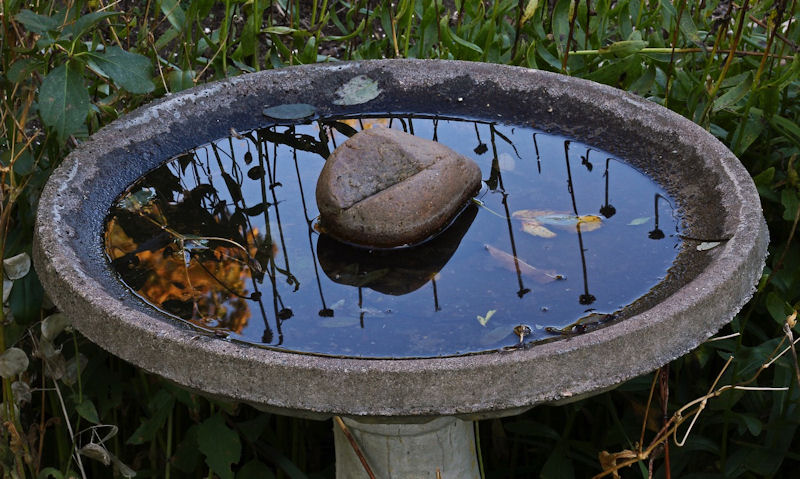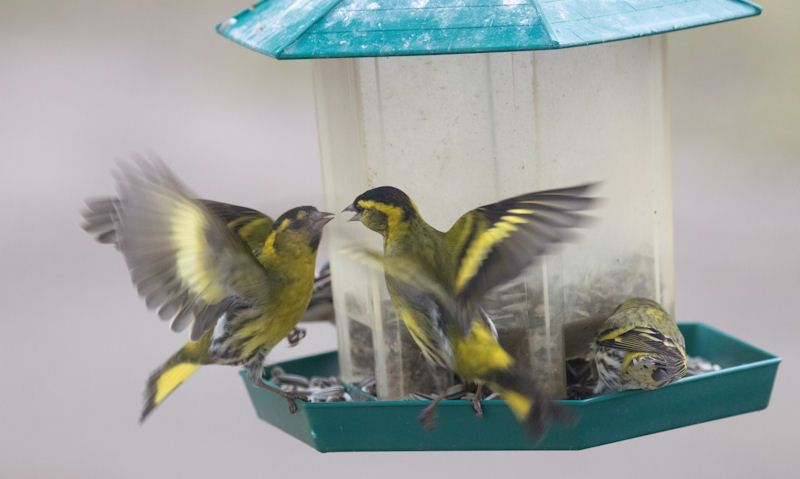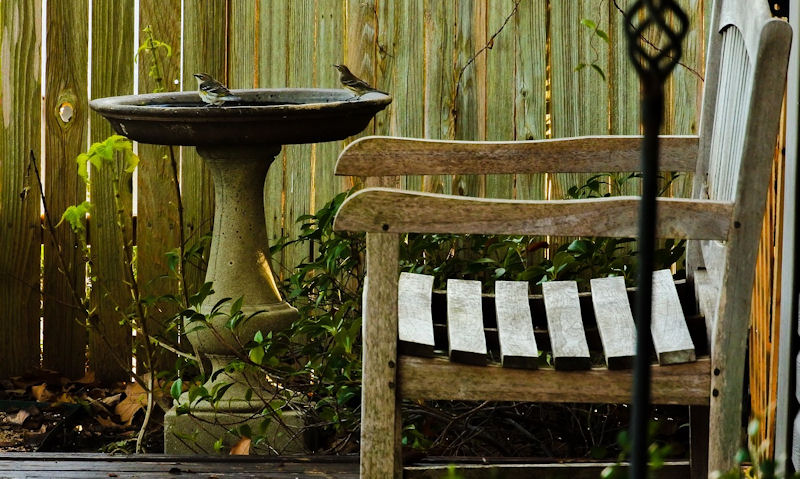Should I put ROCKS in my bird bath
Setting up a bird bath without use of stones or rocks can be quite a bland feature in the garden, so what better way to liven it up while assisting in its use to drink or bathe in.
You should put rocks in your bird bath as it creates more perches for birds to enter the water in a safer way. Site a rock or two in the centre of the bird bath as an alternative to perching on the rim. Allow open water for birds to drink or frolic in - but line the bird bath with stones or pebbles to steady the rocks.
Purpose of adding rocks to a bird bath is for the wellbeing of wild birds; to use rocks is to make sure they have a safe place to perch, while made easier to enter the water.
To use a rock or two in wild birds baths can go one better by at least making sure the rock in use, at least compliments the bird bath theme.
What I mean is a number of grey, rugged rocks can really blend in with a stone bird bath on pedestal - whereas colourful rocks can be distracting, while looking out of place.
Positioning of rocks is at your discretion, but centring them would be more pleasing, or offsetting rocks to one side to allow a larger water pool space.
Bonus of using rocks in a plastic or lightweight bird bath of course, are more heavy rocks can lead to weighing it down in wind - no guarantee mind you but every little helps, but it may still need anchoring to be safe.
Rocks in use can be any shape, providing you prioritise one that is more flat, but wide.
Idea of that is so the rock can stabilise better on a flat bird bath bowl base, yet as its lower down, can see the birds finding it easier to hop in or out of the water.
Rock is safer perch
Allow garden birds to get stuck into your bird bath with ease by positioning one or two large rocks in the bowl - or line it with a dozen smaller rocks.
Common garden birds who use bird baths will have no trouble perching around the rim of the bird bath itself.
Once in a while though the design of the bird bath can be difficult to use if the water is too deep, or is obstructed other ways.
Rocks in a bird bath - presented in a pleasant manner - will not only enhance the bird bath while complimenting the decor of the garden, but its real use is to assist wild birds as they dive into the water to drink or bathe.
It may not seem like much, but to use a series of rocks, or just the larger one - can create a safer environment for birds, while restricting too much boisterous play as busier times.
In positioning the rocks to use as a perch, remember to leave an open area in the water to enter, as to allow them to flap their wings to get a soaking.
Heavier rock is better
Birds that use our gardens to feed or bathe can do so light on their feet, so are very rarely seen to disturb an object - as they're indeed too light to move anything.
Same goes for adding smaller, lighter rocks to the bird bath; there's really no risk of birds moving them if they get a little over energetic.
However, that is not to say an incident can happen with a rock that may roll, topple over or trap them - or worse still even kill them as they risk drowning in the water.
Its therefore up to you to make sure the rocks are always positioned in a stable way.
Heavy rocks would be best for the bird bath as they would normally self-balance under their own weight - whereas lighter rocks can move ever so slightly once in a while.
To guarantee the wellbeing of birds who use your bird bath, only position a rock or two that can steady itself.
Ideally a more flat, wide rock that can never roll if disturbed would be the safest option.
Steady in centre or offset
How you decorate the bird bath in your garden should be pleasing to the eye, but should still compliment the landscape to help it blend in if need be.
Its possible to use one big rock that comes from your own garden to match rocks sat out of it nearby - or use a more decorative rock as bought at the garden centre.
You will want to centre it in the bird bath to allow plenty of room to bathe around it.
To be more creative, there's certainly no harm in offsetting the rock to allow more area in the water for multiple birds to use at once.
It can still be possible to centre or offset one to three medium to large size rocks, if the bird bath bowl size allows it.
Remember the rocks are used as an artificial perch, so should always be setup in a way that can be used as so - by not focusing too much on if it looks right.
Protrude ROCK out of water
To place one to two medium or large size rocks in your bird bath, the idea would be for the rock to be sunk into the water, while allowing a little rock to protrude out.
It is for use as a perch after all so to not use a rock that is lower into the water, can only make it hard for small common garden birds to lean over to sip water.
In a way you want the rock to be 80% underwater, while offering a dry spot on top of the rock so the birds don't have to get their feet wet.
It could be possible wild birds won't use your bird bath this way if it means they have to get wet - so will revert to perching around the bird bath rim.
Protruding rocks can be too far out of the water or be submerged too far under - so do follow my rules of controlling the water depth with use of stones or pebbles.
No trouble would be had with the chance of a rock floating, so it should stay in position during the duration of its use.
Rock texture or shape
No hard or fast rules with the type of rocks to use in your bird bath, it really is up to you what rocks you like, as bought or found in nature.
If you want you could even use an actual house type brick, but to use one of these is not the most attractive thing to be sat in a bird bath.
You will then what to concentrate your effects in matching the rocks with the bird bath decor, or at least the nearby garden decor.
Rocks you should really put in your bird bath would be more flat yet wider than anything else - as this kind of rock does not only stabilise well on the base of the bird bath bowl, but it has greater perch use.
Small or big, just line the rocks on the bird bath bowl in a way they cannot be moved.
Smooth rocks can be attractive to look at, but more rugged, rough rocks in use can create better perching area for wild birds who step over them.
In all this, remember two or three times a month you'd want to clean the bird bath - so the rocks have to be removed before re-positioning them once again.
Line bird bath with pebbles
You can line the bird bath with a dozen smaller rocks of one or two bigger rocks, it really depends on your needs.
But these rocks often sit on the base of what is a slippery, but still quite a deep bird bath bowl that can be a danger to birds who use it.
Especially those that can get trapped in open gaps in-between the rock formation.
I therefore recommend you make use of stones in your bird bath to make it more shallow, but to fill up any area in the rocks that can be a hazard.
Smaller, pebble like stones would be ideal as they can fit in anywhere, whereas larger stones cover a large area, with less stones needed.
You want to prioritise never allowing the water depth to go above 3 to 4cm, with or without rocks in use.
Its possible to use small stones found in the garden but you can buy specialty stones to submerge in water at the pet shop or garden centre.
Conclusion
You should put rocks in your bird bath to create a safe environment, because without rocks it can lead to being hazardous to birds - who decide to use it to drink or bathe.
Use of rocks to create a unique rock formation, produced by hand for birds to rest on top as they decide to drink or enter the water in lower position to bathe.
No rocks is not a problem as wild birds will find a way, only rocks create more natural perches that would hopefully sit nearer to the water line.
Positioning several smaller rocks or one or two larger rocks is within reason, be it if centring them or offsetting over to one side for creative purposes.
While heavier rocks are more stable to use, smaller rocks can move about.
So you can prevent any movement at all by sinking the base of the rock located under the water - in too a helping of stones or pebbles.
Be it a smooth or rugged rock, it doesn't matter with texture so much.
But the shape is important as it needs to lay flat and wide to be more stable, but flatter rocks in use are a little easier for wild birds to enter the water as they have a slope.


